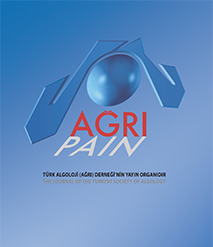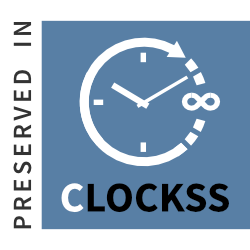Quick Search
Volume: 20 Issue: 2 - 2008
| REVIEW | |
| 1. | Chemonucleolysis in low back pain Gül Köknel Talu, Richard Derby PMID: 19021005 Pages 8 - 13 Low back pain caused by an internally disrupted disc is a universal unresolved problem. Many treatment options have been tried and many are in development, but few have satisfactory long-term results. Although the most often used excuse for inconsistent results is poor patient selection and the lack of objective evaluation parameters, the diagnosis is often elusive and definitive selection criteria for any specific treatment modality is usually unproven. Chemonucleolysis is a cost-effective and simple method for treating both low back pain and sciatica caused by herniated discs where conservative methods are ineffective. |
| EXPERIMENTAL AND CLINICAL STUDIES | |
| 2. | Does iv parocetamol hove preemptive analgesic effect on lumber disc surgeries? Pınar Toygar, Taylan Akkaya, Derya Özkan, Özgür Özel, Ebru Uslu, Haluk Gümüş PMID: 19021006 Pages 14 - 19 In this study, postoperative analgesic effects of intravenous paracetamol administration in lumbar discectomy patients were evaluated. After the approval of ethic committee, 90 patients undergoing lumbar disc hernia operation randomly divided into 3 groups. After standart general anesthesia, patients in group I received 1 gr i.v. paracetamol infusion 15 minutes before the induction, patients in group II received i.v. paracetamol infusion started 15 minutes before the end of surgery. i.v morphine via PCA is used for postoperative analgesia maintenance and patients pain scores were assessed with VAS at 0., 1., 2., 3., 6., 12. and 24. hours. First analgesic requirement time, total morphine consumption and side effects were recorded. In group I and II, VAS scores, 24 h morphine consumption and first morphine requirement times were significantly different comparing to group III. As a result, we think that in lumbar discectomy cases preoperative administration of 1 gr paracetamol has no preemptive analgesic effect. |
| 3. | Doctors’ Opinions, Knowledge And Attitudes Towards Cancer Pain Management In A University Hospital Lütfiye Peker, Nalan Celebi, Ozgur Canbay, Altan Sahin, Banu Cakır, Sennur Uzun, Ulku Aypar PMID: 19021007 Pages 20 - 30 Cancer pain management is still reported to be inadequate despite of recent developments in medicine, resulting in serious outcomes. This study is to evaluate opinions, knowledge and attitudes of doctors working and/or being trainedg in surgical and medical departments in our university hospital, towards cancer pain management via a questionnaire. Of all doctors approached, eighty percent could be reached and 83% of them completed the questionnaire. In this group of doctors, reportedly 60% evaluating cancer patients with pain at least once in a week, most had not have any formal education about cancer pain management during their medical school or residencytraining and the ones reporting "any" education, described this as "limited in quality and as hours of lessons" and were not satisfied. The results of this survey suggest specific targets for the strategic and educational projects to overcome some of the barriers against the optimal cancer pain management. Most of the doctors believe that barriers originating from health professionals and systems are more important than the ones resulting from patients and give high priority to treatment of cancer pain relative to the treatment of cancer; but still half of them report that legal regulations have some influence on opioid prescription; and almost three quarters of them believe that opioid use may cause high rates of psychological addiction or abuse. Two thirds of the doctors feel themselves "insufficient" in cancer pain management, being more prominent in tasks requiring knowledge, skill, education and experience about opioid use. |
| 4. | The Efficacy of Preemptive Ketamine and Ropivacaine in Pediatric Patients: A Placebo Controlled, Double-blind Gül Köknel Talu, Nuri Süleyman Özyalçın, Rukiye Balsak, Meltem Karadeniz PMID: 19021008 Pages 31 - 36 OBJECTIVE: We have evaluated and compared the preemptive efficacy of intravenous ketamine with placebo and caudal ropivacaine in pediatric patients going under elective hernia repair. METHODS: 60 ASAI-II pediatric patients ages between 1-12. The patients were divided into 3 groups randomly. Group K patients had 0.5mg/kg ketamine by intravenous route before induction,Group R patients had 0.7 mg/kg 0.2% ropivacaine caudally and 2ml normal saline intravenously,Group RK patients had 0.7 mg/kg 0.2% ropivacaine caudally and 0.5mg/kg ketamine by intravenous routeAll patients had standard anesthesia technique. Heart rate (HR), pulse oximetry, and systolic and diastolic blood pressure (BP), and BIS (bispectral index) were obtained during anesthesia, In addition, end-tidal carbon dioxide concentration was monitored. The efficacy of postoperative analgesia was documented by objective pain scale (OPS). Analgesic requirements during and after the surgery documented RESULTS: While there was no significant differences in fentanyl consumption between the groups GR and GRK, fentanyl consumption was found to be significantly higher in group K during anesthesia.When compared with GR and GRK, GK had significantly higher OPS values. During postoperative period Group K patients demanded for additional analgesics in significantly shorter time than group R and Group K patients. GK patients had consumed significantly higher amounts of acetaminophen after surgery CONCLUSION: Caudal application of ropivacaine in appropriate doses provides satisfactory peroperative and postoperative analgesia with no side effects in pediatric patient group going under elective hernia repair where as ketamine with the applied doses has no preemptive effect. |
| CLINICAL CONCEPTS AND COMMENTARY | |
| 5. | Gabapentin for neurophatic pain in children: A case report Mürüvet Dayıoğlu, Sema Tuncer, Ruhiye Reisli PMID: 19021009 Pages 37 - 40 Gabapentin is used as an analgesic in neuropathic pain. In this report a children with nerophatic pain because of mercury poising was followed-up for pain and side effects with the use of gabapentin. Pain reduction was good throughout the patient treatment. Severe side effects did not occur. Gabapentin was effective and well tolerated in the treatment of neuropathic pain in children. |
| LETTER TO THE EDITOR | |
| 6. | Relationship Between Migraine and Patent Foramen Ovale Vijay K Sharma, Hock L Teoh, Bernard P. L. Chan PMID: 19021010 Pages 41 - 43 Cerebral embolization through a PFO is considered to be a possible cause of migraine attack, therefore the size of the PFO and its ‘functional potential’ should play an important etiological role in migraine. However, this relationship remains complex due to various methodological issues. We have highlighted some of the important issues related to the diagnostic methodology for PFO and the interpretation of the results. Mere detection of the presence of PFO in patients with migraine may not delineate their true relationship for a better understanding and planning a definitive treatment. There is an urgent need for standardizing the diagnostic methods as well as the criteria for the grading the ‘functional status’ of PFO. |
| ABSTRACTS | |
| 7. | Abstracts Pages 44 - 47 Abstract | |
| BOOK REVIEW | |
| 8. | Book Review: Pain Medicine and Management just the facts Gül Köknel Talu, Selçuk Dinçer Pages 48 - 49 Abstract | |





